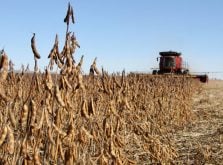Slumping oil prices have taken the shine off the Canadian loonie but that is brightening revenue prospects for the country’s grain and livestock producers.
After rising 17 percent in 2007, the Canadian dollar has depreciated about 4.5 percent so far in 2008, mainly because of the recent tailspin in oil prices.
A barrel of oil that was selling at a record high of $148 U.S. July 11 was fetching less than $114 Aug. 11. A loonie that was on par with the U.S. dollar at the end of 2007 was trading below 94 cents Aug. 11.
Read Also

Manitoba extends Crown land rent freeze
Manitoba government links the continued rental rate freeze on grazing and forage leases to economic and environmental challenges facing the industry
“The Canadian dollar is viewed very much still as a commodity related currency, an oil currency. That’s really the key reason why our dollar has fallen off,” said Patricia Mohr, vice-president of economics and a commodity market specialist at Scotiabank.
Many analysts predict a further gradual decline in the loonie. The median estimate of 31 currency strategists surveyed by Bloomberg called for the currency to slide to 91.7 cents US by the end of 2009.
Peter Hall, chief economist with Export Development Canada, expects the dollar to drop to the low or mid-90s by the end of 2008 and to find a home in the 82 to 85 cents U.S. range over the longer term.
“It’s fundamentally overvalued where it’s at right now,” said Hall.
The market now believes oil, base metals and other commodities are overpriced and that the world has entered a period of global economic slowdown, he said.
“We don’t believe that there’s going to be a snappy rebound in the world economy next year, so the same sort of drivers are in place that are going to keep the Canadian dollar weakening as we go forward,” he said.
Losing ground to the U.S. dollar is good news for exporters of Canadian agricultural products because selling prices are based in U.S. dollars. That means grain and livestock producers receive more Canadian dollars for every transaction.
“It’s a big deal. It’s a very big deal,” said Larry Martin, senior research fellow with the George Morris Centre.
While the recent decline hasn’t been monumental, if the dollar gets to the 90 cent range that analysts are predicting, it means producers will get 10 percent more for their products than they were at the end of 2007.
The beauty of a declining dollar is that inputs like fertilizer, chemicals and feed would have been purchased when the dollar was higher, which means margins would be increasing by even more than 10 percent.
“It’s a wonderful thing when it’s going in your favour and it’s a terrible thing when it’s going against you,” said Martin.
Any commodity traded on a daily basis is vulnerable to currency fluctuations unless it is something like dairy that is divorced from the U.S. market. Corn farmers in Eastern Canada can witness the immediate impact of a depreciating dollar.
“It goes directly into our bids and offers for our corn in Ontario,” said Martin.
A western Canadian wheat farmer who is participating in the Canadian Wheat Board’s pooling program wouldn’t see as direct an influence, he added.
There is a point where, if the currency plummets too far, it could be detrimental to the farm economy, but Hall said there is no need to panic.
“We’re talking about a gentle depreciation. We’re not fully unwinding the appreciation we saw in 2007.”
Contrary to her fellow economists, Mohr sees no further decline in the dollar, largely because she believes markets have not properly accounted for the tight supply of oil in regions outside of the Organization of Petroleum Exporting Countries.















